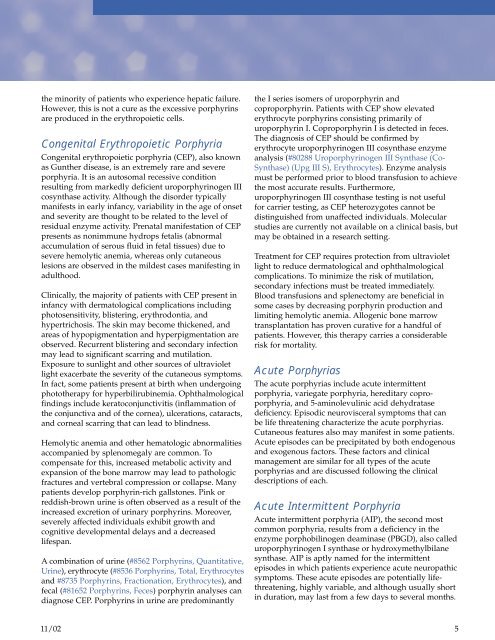The Challenges Of Testing For And Diagnosing Porphyrias
The Challenges Of Testing For And Diagnosing Porphyrias
The Challenges Of Testing For And Diagnosing Porphyrias
Create successful ePaper yourself
Turn your PDF publications into a flip-book with our unique Google optimized e-Paper software.
the minority of patients who experience hepatic failure.<br />
However, this is not a cure as the excessive porphyrins<br />
are produced in the erythropoietic cells.<br />
Congenital Erythropoietic Porphyria<br />
Congenital erythropoietic porphyria (CEP), also known<br />
as Gunther disease, is an extremely rare and severe<br />
porphyria. It is an autosomal recessive condition<br />
resulting from markedly deficient uroporphyrinogen III<br />
cosynthase activity. Although the disorder typically<br />
manifests in early infancy, variability in the age of onset<br />
and severity are thought to be related to the level of<br />
residual enzyme activity. Prenatal manifestation of CEP<br />
presents as nonimmune hydrops fetalis (abnormal<br />
accumulation of serous fluid in fetal tissues) due to<br />
severe hemolytic anemia, whereas only cutaneous<br />
lesions are observed in the mildest cases manifesting in<br />
adulthood.<br />
Clinically, the majority of patients with CEP present in<br />
infancy with dermatological complications including<br />
photosensitivity, blistering, erythrodontia, and<br />
hypertrichosis. <strong>The</strong> skin may become thickened, and<br />
areas of hypopigmentation and hyperpigmentation are<br />
observed. Recurrent blistering and secondary infection<br />
may lead to significant scarring and mutilation.<br />
Exposure to sunlight and other sources of ultraviolet<br />
light exacerbate the severity of the cutaneous symptoms.<br />
In fact, some patients present at birth when undergoing<br />
phototherapy for hyperbilirubinemia. Ophthalmological<br />
findings include keratoconjunctivitis (inflammation of<br />
the conjunctiva and of the cornea), ulcerations, cataracts,<br />
and corneal scarring that can lead to blindness.<br />
Hemolytic anemia and other hematologic abnormalities<br />
accompanied by splenomegaly are common. To<br />
compensate for this, increased metabolic activity and<br />
expansion of the bone marrow may lead to pathologic<br />
fractures and vertebral compression or collapse. Many<br />
patients develop porphyrin-rich gallstones. Pink or<br />
reddish-brown urine is often observed as a result of the<br />
increased excretion of urinary porphyrins. Moreover,<br />
severely affected individuals exhibit growth and<br />
cognitive developmental delays and a decreased<br />
lifespan.<br />
A combination of urine (#8562 Porphyrins, Quantitative,<br />
Urine), erythrocyte (#8536 Porphyrins, Total, Erythrocytes<br />
and #8735 Porphyrins, Fractionation, Erythrocytes), and<br />
fecal (#81652 Porphyrins, Feces) porphyrin analyses can<br />
diagnose CEP. Porphyrins in urine are predominantly<br />
the I series isomers of uroporphyrin and<br />
coproporphyrin. Patients with CEP show elevated<br />
erythrocyte porphyrins consisting primarily of<br />
uroporphyrin I. Coproporphyrin I is detected in feces.<br />
<strong>The</strong> diagnosis of CEP should be confirmed by<br />
erythrocyte uroporphyrinogen III cosynthase enzyme<br />
analysis (#80288 Uroporphyrinogen III Synthase (Co-<br />
Synthase) (Upg III S), Erythrocytes). Enzyme analysis<br />
must be performed prior to blood transfusion to achieve<br />
the most accurate results. Furthermore,<br />
uroporphyrinogen III cosynthase testing is not useful<br />
for carrier testing, as CEP heterozygotes cannot be<br />
distinguished from unaffected individuals. Molecular<br />
studies are currently not available on a clinical basis, but<br />
may be obtained in a research setting.<br />
Treatment for CEP requires protection from ultraviolet<br />
light to reduce dermatological and ophthalmological<br />
complications. To minimize the risk of mutilation,<br />
secondary infections must be treated immediately.<br />
Blood transfusions and splenectomy are beneficial in<br />
some cases by decreasing porphyrin production and<br />
limiting hemolytic anemia. Allogenic bone marrow<br />
transplantation has proven curative for a handful of<br />
patients. However, this therapy carries a considerable<br />
risk for mortality.<br />
Acute <strong>Porphyrias</strong><br />
<strong>The</strong> acute porphyrias include acute intermittent<br />
porphyria, variegate porphyria, hereditary coproporphyria,<br />
and 5-aminolevulinic acid dehydratase<br />
deficiency. Episodic neurovisceral symptoms that can<br />
be life threatening characterize the acute porphyrias.<br />
Cutaneous features also may manifest in some patients.<br />
Acute episodes can be precipitated by both endogenous<br />
and exogenous factors. <strong>The</strong>se factors and clinical<br />
management are similar for all types of the acute<br />
porphyrias and are discussed following the clinical<br />
descriptions of each.<br />
Acute Intermittent Porphyria<br />
Acute intermittent porphyria (AIP), the second most<br />
common porphyria, results from a deficiency in the<br />
enzyme porphobilinogen deaminase (PBGD), also called<br />
uroporphyrinogen I synthase or hydroxymethylbilane<br />
synthase. AIP is aptly named for the intermittent<br />
episodes in which patients experience acute neuropathic<br />
symptoms. <strong>The</strong>se acute episodes are potentially lifethreatening,<br />
highly variable, and although usually short<br />
in duration, may last from a few days to several months.<br />
11/02 5

















